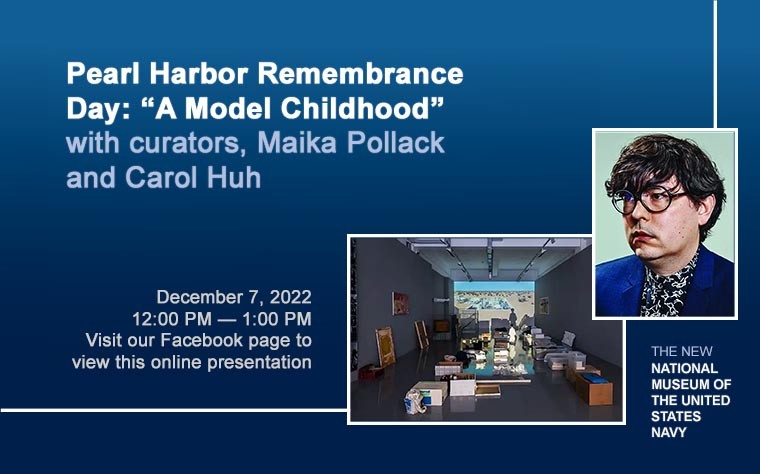Curators Maika Pollack and Carol Huh
Curators, Maika Pollack, and Carol Huh, discuss and dissect the art work, “A Model Childhood” by contemporary artist Ken Okiishi. This multi-layered installation is a poetic meditation on race, memory, and belonging that uses the 1941 attack on Pearl Harbor as a platform to examine the origins of anti-Asian bias and racism and the meaning of citizenship.
“Everyone suffers from this history that has never been properly worked through and it continues to be played out on the faces and bodies of all Asian Americans up to and including in the present."
Ken Okiishi
About the Curators:
Maika Pollack is Director and Chief Curator, John Young Museum of Art (JYMA) and University Galleries, and Assistant Professor of Curatorial Studies and Art History, University of Hawaii at Mānoa. Pollack curated the exhibition, A Model Childhood for JYMA. Previously, she was Co-founder and Director of Southfirst (2000-2018), a contemporary art space in Williamsburg, Brooklyn that presented experimental exhibitions for more than a decade. Shows she has curated have frequently been reviewed in The New York Times, The New Yorker, Art in America, ArtNews, and Artforum, among other publications. Prior to Southfirst, she worked at PS1 Contemporary Art Center, in Queens, where, as the sole curatorial assistant to the Chief Curator, was integral in programming the earliest iterations of the popular “Warm Up” summer program. She also founded the imprint Object Relations, which printed several books featuring rare texts including Excerpts from the 1971 Journal of Rosemary Mayer (2016) and Joe Gibbons: Drawings From Rikers (2017).
Pollack has a PhD in Art History from Princeton University. Her writing on contemporary art and culture has been published by The New York Times, Interview, ArtNews, Arforum, BOMB, Aperture, and The Brooklyn Rail. She was the Museum Exhibition Critic for The New York Observer from 2011-2015.
Carol Huh, is associate curator of contemporary Asian art, and the first curator of contemporary art at the Smithsonian’s National Museum of Asian Art, in 2007. Huh focuses on current artistic production related to Asia through exhibitions, acquisitions, and public programs. Recent projects include the museum’s groundbreaking series of contemporary art installations in the Sackler pavilion, featuring works by Y.Z. Kami, Anish Kapoor, Hai Bo, Hale Tenger, Rina Bannerjee, Ai Weiwei, Chiharu Shiota, Michael Joo, and Subodh Gupta, among others. Huh organized Moving Perspectives, the Sackler’s first series of exhibitions focusing on video art from Asia. Special exhibitions include Japan Modern: Photographs from the Gloria Katz and Willard Huyck Collection (2018), Notes from the Desert: Photographs by Gauri Gill (2016), Symbolic Cities: The Work of Ahmed Mater (2016), Sense of Place: Landscape Photographs from Asia (2013), Nine Deaths, Two Births: Xu Bing’s Phoenix Project (2013), Shadow Sites: Recent Work by Jananne al-Ani (2012), and Fiona Tan: Rise and Fall (in-house curator, 2010).
Huh is a member of the Smithsonian Artist Research Fellowship Committee and the Smithsonian Networks Review Committee. She completed her undergraduate and graduate studies at Georgetown University, Washington, DC.
About the Artist: Ken Okiishi was born in 1978 in Ames, Iowa, and currently lives and works in New York. He works employs disparate media systems that hover over and within relationships between matter and memory, perception and action, image-networks and language-systems, often confronting our personal perceptions of culture and social norms. His most recent solo exhibitions include: A Model Childhood, University of Hawaii, Manoa (2022). He has exhibited at The Museum of Modern Art, New York (2015); Whitney Biennial 2014, and the Whitney Museum of American Art, New York (2014).
About “A Model Childhood”: In A Model Childhood, Okiishi approaches history through the lens of family and oral history, bringing both an intimacy and complexity to official narratives of the time period. Immediately after the bombing of Pearl Harbor in 1941, Okiishi’s grandfather, following a frantic phone call from his brother, whose house had just been searched by the Honolulu police looking for connections to Japan, decided to suddenly unload all traces of the family’s Japanese possessions by dumping them into Māmala Bay. This leitmotif of American identity formation haunts what ensues.
The exhibition consists of multiple interlocking parts, including: A display of the totality of Okiishi’s childhood belongings (1978–2001), meticulously archived by his parents, who had settled in the university town of Ames, Iowa in the late 1950s; A video, projected on and through this childhood archive, which shows a view of walking through the ruins of the Topaz War Relocation Center, a concentration camp in Delta, Utah; A video showing a forensic scan of the basement of Okiishi’s family home set into a desert landscape, documenting the family’s basement archive before the removal of the section dedicated to Ken’s childhood; A family history video for insurance purposes, made by the artist’s mother, documenting every object in the Okiishi household circa 2009; A large banner made from a photograph of a Boys’ Day memento from 1940—Okiishi’s father as an infant, posed amid fifty Japanese dolls depicting the life of a warrior which were thrown into the ocean upon the threat of internment a year later.
Finally, a photographic slideshow of Okiishi’s cross-country trip in 2018, with more than 300 photographic images, shows a process whereby the modes of landscape and road trip photography are recorded via an eye that no longer sees the ideological function of those modes of image production as related to American expanse and freedom.

Graphics banner for the presentation on December 7, 2022.




